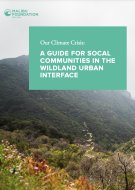
As early February brings heat alerts for communities in Southern California following an otherwise dry January, VX News shares the latest report by the Malibu Foundation assessing the social vulnerabilities and physical hazards of living in Southern California's Wildland Urban Interface. The report, authored by Shea Cunningham, principal and Chief Sustainability Strategist at Balanced Approach, and Dean Kubani, former City of Santa Monica CSO, is a comprehensive risk assessment that offers recommendations for equitably addressing resilience challenges facing communities in the Santa Monica Mountains. Click here to read the full report online, and find a webinar presentation of the report findings, here.
Introduction
The communities of the Santa Monica Mountains (SMM) are particularly vulnerable to natural hazards such as earthquakes, fires, and landslides and the increasing impacts of climate change, including prolonged droughts, extreme heat and precipitation, storm surges and sea level rise. In November 2018, the devastating Woolsey Fire burned over 97,000 acres and destroyed over 1,600 homes and other structures in the cities of Malibu, Agoura Hills, Calabasas, Westlake Village and the unincorporated SMM area. Three years after the Woolsey Fire, the region is still in the difficult process of recovering.
Unfortunately, this challenging time has been compounded by the COVID-19 pandemic, which has had a profound impact on local economies and the health and well-being of the community – especially for its less affluent residents and older adults. However, “The Great Reset” also presents the region with an opportunity to create more awareness about climate change and proactively build resilience to the resulting shocks and stressors of climate change – including hotter, faster, and more frequent wildfires. It is an opportunity to help minimize the loss of property, lives and livelihoods and be better prepared when the next disaster strikes. It is also an opportunity to strengthen community cohesion, equity, and inclusion by identifying and supporting the most vulnerable populations within the region.
In January 2021, the Malibu Foundation formed a collaboration with a broad range of community stakeholder groups and local experts to conduct a climate vulnerability assessment and resilience plan for the SMM wildland-urban interface (WUI) cities of Malibu, Agoura Hills, Calabasas, Hidden Hills and Westlake Village (which form the Las Virgenes Council of Governments), as well as Topanga, the Pacific Palisades, Sunset Mesa and adjacent unincorporated SMM communities.
Key Definitions
Climate vulnerability can be defined as susceptibility to exposure to the hazards associated with climate change, such as more frequent and persistent droughts, more intense storms and wildfires, sea level rise and coastal flooding, and more frequent extreme heat events. Climate resilience, on the other hand, is the ability to withstand the impacts of these climate related hazards. Community resilience relates to the ability of individuals and neighborhoods to support each other before, during, and after a disaster or crisis, strengthening connections within and between communities, and developing comprehensive support systems.
The wildland urban interface (WUI) is the transition zone between wilderness and land developed by human activity, an area where a built environment intermingles with the natural environment. Human settlements in the WUI are at a greater risk of catastrophic wildfire and several other climate hazards. The US Forest Service defines the WUI as a place where “humans and their development meet or intermix with wildland fuel.”
This report seeks to:
1. Increase local knowledge about the SMM WUI region’s climate hazards, the resulting impacts on infrastructure and community resources, and the region’s diverse populations;
2. Provide recommendations to address and prepare for the disruptive, and potentially devastating impacts of climate change in the region; and
3. Serve as an actionable plan for regional coordination by local governments and regional agencies on climate resilience strategies, and as a community resilience guide for individuals, neighborhood groups and other stakeholders in the region.
Methodology
This study is based on the following:
1. Community Surveys: Qualitative results from an on-line community survey based on Los Angeles County’s 2020 adaptive capacity survey. Survey respondents were asked 67 questions in seven categories: 1) Demographics, (2) Climate Change & Woolsey Fire, (3) Extreme Heat, (4) Wildfire, (5) Floods, (6) Communications & Mobility, and (7) Mitigation, Sustainability & Preparedness. More than four hundred residents of the SMM WUI region participated in this survey between February and March 2021.
2. Listening Sessions: Analysis from two listening sessions focused on older adults and day laborers/domestic workers. A total of thirty-five people participated in these sessions.
3. Community Asset Inventory: A catalog of critical community infrastructure was compiled to identify the region’s key physical resources and help assess its physical vulnerabilities and climate resilience.
4. Research and Data Analysis: Reviews of key studies, including LA County’s 2021 Climate Vulnerability Assessment, analysis of census data, and the use of several other databases and statistical sources including CalAdapt, the National Oceanic and Atmospheric Administration (NOAA), and the Coastal Storm Modeling System (CoSMoS) informed this report and its conclusions.
Continue reading the full report and recommendations online, here.
